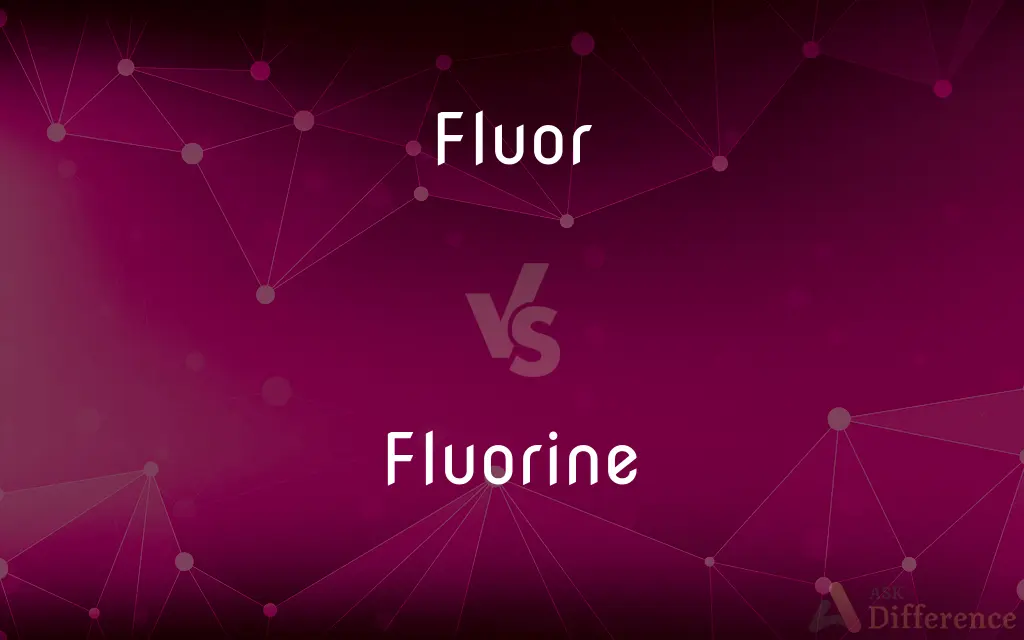Fluor vs. Fluorine — What's the Difference?
Edited by Tayyaba Rehman — By Maham Liaqat — Updated on April 4, 2024
Fluor refers to the mineral form or ionic compounds containing fluorine, emphasizing its presence in various substances, while fluorine is a highly reactive, pale yellow gas, the element itself, crucial in chemistry and industry.

Difference Between Fluor and Fluorine
Table of Contents
ADVERTISEMENT
Key Differences
Fluor is a term often used in mineralogy and materials science to denote substances that contain fluorine ions, such as calcium fluoride (fluorite) or in the context of ionic compounds where fluorine is combined with another element. This usage highlights the presence and role of fluorine within compounds, particularly those used in various industrial and manufacturing processes. On the other hand, fluorine is the chemical element itself, with the atomic number 9. It is known for being the most electronegative and reactive of all the elements, making it a key component in many chemical reactions and industrial applications, such as in the production of Teflon and refrigerants.
The distinction between fluor and fluorine lies not just in their physical and chemical properties but also in their applications and significance in different contexts. Fluor, being related to compounds, is significant in the geological and materials sciences, where the focus is on the behavior and usage of fluorine-containing minerals and substances. Whereas, fluorine, as an element, is primarily of interest in chemistry and industrial processes where its reactivity is harnessed for specific purposes, including the synthesis of various organic and inorganic compounds.
The terminology surrounding fluor and fluorine also reflects the broader distinction between the study of minerals and materials (fluor) and the study of elements and their reactions (fluorine). Understanding this distinction is important for professionals in chemistry, materials science, and related fields, as it influences how substances are studied, manipulated, and applied in real-world scenarios.
While fluor compounds are utilized for their specific properties, such as fluorescence or chemical stability, fluorine gas requires careful handling due to its highly reactive nature. This reactivity, however, is what makes fluorine valuable in creating compounds with unique properties, including high resistance to heat and chemical reactivity, as seen in fluoropolymers and other fluorinated compounds.
The relationship between fluor and fluorine illustrates the interconnectedness of elements and their compounds in scientific and industrial applications. By comprehending the nuances of each, researchers and engineers can better exploit their properties for technological advancements and practical applications, from enhancing the durability of materials to developing pharmaceuticals and improving chemical synthesis processes.
ADVERTISEMENT
Comparison Chart
Definition
Refers to mineral forms or compounds containing fluorine ions
The chemical element with atomic number 9, a highly reactive gas
Context
Mineralogy, materials science
Chemistry, industrial processes
Properties
Depends on the specific compound; generally involves fluorine in ionic form
Pale yellow gas, most electronegative and reactive element
Applications
Used in the manufacturing of glass, ceramics, and in metallurgy
Used in the production of fluorinated organic compounds, refrigerants, and in nuclear fuel processing
Handling and Safety
Safety concerns depend on the compound; generally less reactive than elemental fluorine
Requires careful handling due to high reactivity and potential for corrosive effects
Compare with Definitions
Fluor
Often used to describe substances that exhibit fluorescence due to the presence of fluorine.
The fluor in this gemstone gives it a remarkable glow under UV light.
Fluorine
Known for being the most electronegative element, making it extremely reactive.
Fluorine readily forms compounds with almost all other elements.
Fluor
Any mineral or material containing fluorine ions in its composition.
Fluorapatite, a mineral rich in fluor, is used in toothpaste for its fluoride content.
Fluorine
Utilized in the manufacture of substances like Teflon due to its chemical properties.
The non-stick properties of Teflon are due to the fluorine it contains.
Fluor
Related to the extraction and processing of fluorine-containing minerals.
The mining of fluor minerals is critical for the fluorine chemical industry.
Fluorine
Essential in creating fluorinated pharmaceuticals and agrochemicals.
Many modern medicines contain fluorine to enhance their effectiveness.
Fluor
Refers to ionic compounds of fluorine with metals, important in various industrial applications.
Aluminum fluor is essential in aluminum smelting processes.
Fluorine
Plays a critical role in the nuclear industry for uranium enrichment.
Fluorine is used in the form of uranium hexafluoride for nuclear fuel.
Fluor
A term indicating the presence of fluorine in minerals used for decorative or practical purposes.
Fluor-bearing minerals are prized for their beauty and industrial uses.
Fluorine
A diatomic, highly reactive, pale yellow gas at room temperature.
Fluorine gas is used in the chemical industry for high-strength polymer production.
Fluor
See fluorite.
Fluorine
Fluorine is a chemical element with the symbol F and atomic number 9. It is the lightest halogen and exists at standard conditions as a highly toxic, pale yellow diatomic gas.
Fluor
(dated) The mineral fluorite.
Fluorine
A pale-yellow, highly corrosive, poisonous, gaseous halogen element, the most electronegative and most reactive of all the elements, existing as a diatomic gas (F2) and used in a wide variety of industrially important compounds. Atomic number 9; atomic weight 18.9984; melting point -219.67°C; boiling point -188.12°C; specific gravity of liquid 1.50 (at boiling point); valence 1. See Periodic Table.
Fluor
(obsolete) A flow or flux.
Fluorine
(uncountable) The chemical element (symbol F) with an atomic number of 9. It is the lightest of the halogens, a pale yellow-green, highly reactive gas that attacks all metals.
Fluor
Menstrual periods.
Fluorine
A single atom of this element.
An octahedron of fluorines
Fluor
A fluid state.
Fluorine
A non-metallic, gaseous element of atomic number 9, strongly acid or negative, and associated with chlorine, bromine, and iodine, in the halogen group of which it is the first member. It always occurs combined, is very active chemically, and possesses such an avidity for most elements, and silicon especially, that it can neither be prepared nor kept in glass vessels, but may be contained in lead vessels. If set free it immediately attacks a containing glass vessel, so that it was not isolated until 1886. It is a pungent, corrosive, colorless gas. Symbol F. Atomic weight 19.00.
Fluor
Menstrual flux; catamenia; menses.
Fluorine
A nonmetallic univalent element belonging to the halogens; usually a yellow irritating toxic flammable gas; a powerful oxidizing agent; recovered from fluorite or cryolite or fluorapatite
Fluor
See Fluorite.
Fluor
A soft mineral (calcium fluoride) that is fluorescent in ultraviolet light; chief source of fluorine
Common Curiosities
Why is fluorine considered so reactive?
Fluorine is the most electronegative element, meaning it has a strong tendency to attract electrons from other elements, making it highly reactive.
How is fluorine handled safely?
Due to its reactivity, fluorine must be stored and used in specific conditions that prevent its reaction with other materials, typically in steel cylinders under controlled environments.
Is fluorine found in nature?
Fluorine exists in nature combined with other elements in minerals, but it is not found in its elemental form due to its high reactivity.
Can fluor compounds be dangerous?
While fluor compounds vary widely in their properties, some can be hazardous if not handled properly, although they are generally less reactive than elemental fluorine.
What are the benefits of fluor in everyday products?
Fluor-containing compounds, such as fluoride in toothpaste, contribute to dental health, and fluorinated materials are used for their durability and resistance to heat and chemicals.
Are there any biological roles for fluor or fluorine?
In its ionic form (fluoride), fluor plays a critical role in dental and bone health by helping to prevent tooth decay and strengthen bone structure. Elemental fluorine, due to its reactivity, does not have a direct biological role.
What are the industrial uses of fluorine?
Fluorine is used in the production of fluorocarbons for refrigerants, polymers like Teflon, and in the enrichment of uranium for nuclear fuel.
What is the primary difference between fluor and fluorine?
Fluor refers to compounds or minerals containing fluorine, while fluorine is the elemental gas known for its extreme reactivity.
Where is fluor commonly found?
Fluor is found in various minerals and compounds, such as fluorite and fluorapatite, used in industrial and manufacturing processes.
How is fluorine extracted for industrial use?
Fluorine is industrially produced through the electrolysis of hydrogen fluoride in a solution of potassium fluoride. This process separates fluorine gas from the fluoride ions in solution.
How does fluorine react with organic compounds?
Fluorine reacts vigorously with most organic compounds, often resulting in the substitution of hydrogen atoms with fluorine. This reaction can significantly alter the properties of the organic compound, making it more resistant to chemicals and heat.
How do fluor and fluorine contribute to environmental concerns?
While fluor compounds like CFCs have raised environmental concerns due to their role in ozone depletion, fluorine in controlled applications does not directly contribute to such issues. Environmental impacts depend on specific compounds and their uses.
What role does fluor play in the environment?
Fluor, especially in the form of naturally occurring minerals, is part of the Earth's crust and participates in various geochemical cycles. It can also influence local ecosystems through its presence in water and soil.
What safety measures are necessary when working with fluorine?
Working with fluorine gas requires strict safety protocols, including the use of protective equipment to prevent inhalation and contact, and storage in compatible containers to avoid reactions with other materials.
Share Your Discovery

Previous Comparison
Repeated vs. Repetitive
Next Comparison
Limerick vs. SonnetAuthor Spotlight
Written by
Maham LiaqatEdited by
Tayyaba RehmanTayyaba Rehman is a distinguished writer, currently serving as a primary contributor to askdifference.com. As a researcher in semantics and etymology, Tayyaba's passion for the complexity of languages and their distinctions has found a perfect home on the platform. Tayyaba delves into the intricacies of language, distinguishing between commonly confused words and phrases, thereby providing clarity for readers worldwide.
















































